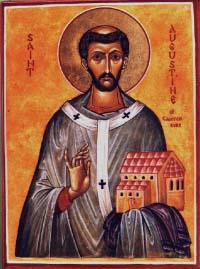The History of the Archbishop of Canterbury
Records suggest that the Roman Britons had three Archbishops, seated in London, York, and Caerleon, an ancient city of South Wales. However, in the fifth and sixth centuries the country was overrun by the Anglo-Saxons. Of the kingdoms they set up there, Kent had the closest ties to European trade and culture.
 The first Archbishop of Canterbury was Saint Augustine, who arrived in Kent in 597, sent by Pope Gregory the Great to mission to the English. He was accepted by King Ethelbert, on his conversion to Christianity, around the year 598. Since then the Archbishops of Canterbury have been referred to as occupying the Chair of St Augustine. The first Archbishop of Canterbury was Saint Augustine, who arrived in Kent in 597, sent by Pope Gregory the Great to mission to the English. He was accepted by King Ethelbert, on his conversion to Christianity, around the year 598. Since then the Archbishops of Canterbury have been referred to as occupying the Chair of St Augustine.
This was the first ever papal mission, and Augustine built a priory on the site of the present cathedral precincts in AD 597. He also built an abbey outside the city walls where he was buried, as were other early archbishops. Though St. Gregory had planned the division of England into two archbishoprics, one at London and one at York, Augustine's success at Canterbury explains how the southern archiepiscopal see came to be fixed there instead of at London. The first beginnings of the diocese are told by St. Bede (Hist. Eccl., I, xxxiii). "When Augustine, the first Archbishop of Canterbury, assumed the episcopal throne in that royal city, he recovered therein, by the King's assistance, a church which, as he was told, had been constructed by the original labour of Roman believers. This church he consecrated in the name of the Saviour, our God and Lord Jesus Christ, and there he established an habitation for himself and all his successors". The church was Saint Martin's, which is still in use today, and is considered the oldest church in England still in use. The Ancient Diocese of Canterbury was the Mother-Church and Primatial See of All England, from 597 till the death of the last Catholic Archbishop, Cardinal Pole, in 1558.
Before the break with Papal authority in the 16th Century, the Church of England was an integral part of the worldwide Roman Catholic Church. The present Church of England, an established national church, still considers itself part of the broader Western Catholic tradition as well as being the "mother church" of the worldwide Anglican Communion.
The Archbishop of Canterbury is the head of the Church of England and of the worldwide Anglican Communion. He is the direct successor of St Augustine, the first Archbishop from AD 597 to 605. The present incumbent is Rowan Williams.
The question of whether the Archbishop of Canterbury or the Archbishop of York should take precedence was once a cause of a long struggle. The dispute was temporarily resolved in 1071 after Lanfranc, Archbishop of Canterbury, and Thomas of Bayeux, Archbishop of York, submitted the matter to the Pope. Pope Alexander II decided that Canterbury was to have precedence, and that future Archbishops of York would have to be consecrated by, and swear allegiance to, the Archbishop of Canterbury.
In 1119, however, the Archbishop-Elect of York, Thurstan, refused to acknowledge the pre-eminence of Canterbury. As a consequence, the Archbishop of Canterbury, Ralph d'Escures, refused to consecrate him. When Thurstan appealed to Rome, Pope Callixtus II not only personally consecrated him, but also issued a papal bull repudiating the supremacy of Canterbury. The matter was finally settled by Pope Innocent VI during the 14th century. Under Pope Innocent's arrangement, which lasts to this day, the Archbishop of Canterbury would be recognised as superior to the Archbishop of York. The former would be acknowledged as "Primate of All England," and the latter as "Primate of England." The pre-eminence of the Archbishop of Canterbury is acknowledged by an Act of Parliament passed during the reign of Henry VIII.
The Archbishop of Canterbury also has a precedence of honour over the other archbishops of the Anglican Communion. He is recognised as primus inter pares, or first amongst equals. The Archbishop of Canterbury, however, does not exercise any direct authority in the provinces outside England.
In the order of precedence, the Archbishop of Canterbury is ranked above all individuals in the realm, with the exception of the Sovereign and members of the Royal Family. Immediately below him is the Lord Chancellor, and then the Archbishop of York.
Related Articles:
- Canterbury: Still the Perfect Pilgrimage!, by Julia Hickey
- https://www.timetravel-britain.com/articles/towns/canterbury.shtml
- Canterbury Cathedral, by John P. Seely
- https://www.timetravel-britain.com/articles/churches/canterbury.shtml
- St. Augustine's Abbey
- https://www.timetravel-britain.com/articles/history/abbey.shtml
- Article reprinted from Wikipedia.org:
- http://en.wikipedia.org/wiki/Canterbury
- http://en.wikipedia.org/wiki/Archbishop_of_Canterbury
- http://en.wikipedia.org/wiki/Church_of_St._Martin%2C_Canterbury
|
